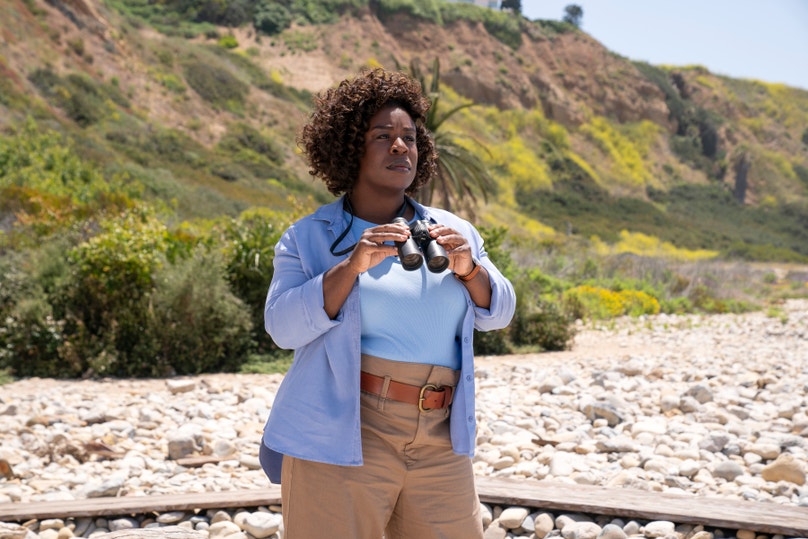Behind the (Birding) Scenes on the Show ‘The Residence’
Bird expert Kenn Kaufman shares his experience as a consultant for the birdy new Netflix series.

A new Netflix miniseries, The Residence, launched in late March. A madcap comedy/murder mystery set in the White House, it quickly drew fans for its ingenious plot, snappy dialogue, and memorable acting. But birdwatchers took note for an extra reason. The show’s main character is not only the world’s greatest detective—she’s also an avid birder. Insights and skills gained from birding help her spot clues and solve cases.
That avian element came as a surprise to most birders. But I knew about it already because for more than three years I had been a birding consultant for the miniseries. Since the show’s release, friends have peppered me with questions about it, so I decided to write about my experience as the behind-the-scenes bird guy.
It began with a request from a stranger in August 2021. Eileen Hutchinson was working with producer and writer Paul Willam Davies on a new miniseries in which one character was a birder. Eileen had seen my “Ask Kenn” column for Audubon magazine, so she proceeded to ask: Could I help with a few questions about birds?
Of course I said yes. Popular culture in America tends to treat birding as a joke, so it’s a pleasant surprise when a TV producer takes it seriously enough to want accuracy.

And of course I scoped out the work of Paul William Davies. Impressive guy—he had been a writer on multiple TV series from production company Shondaland, including Scandal, and had created and written For the People. (He has degrees in history and law, too.) But in our first phone conversation, he was the furthest thing in the world from a Hollywood big shot: friendly, witty, modest, open to suggestions. He and Eileen already had read dozens of books and articles about birds. He wanted his new character, ace detective Cordelia Cupp, to be totally convincing as an avid birder—even for avid birders in the audience. So at first we just discussed what Cupp might say about hawks and falcons in a certain scene.
For someone like me, steeped in bird-geek detail, it was a blast.
Things developed gradually after that, with the occasional exchange of messages. But by several months later I was an official consultant on the show, reading full scripts and providing written comments. For someone like me, steeped in bird-geek detail, it was a blast.
In one scene, detective Cupp mentions staying awake for 43 hours looking for a particular bird. We discussed possibilities and settled on Buff-collared Nightjar—elusive day and night, and rare north of the Mexican border. One scene required Cupp to be on a remote beach looking for a rare bird—we made it a Tuamotu Sandpiper, on an unnamed island in French Polynesia. Typical of Paul’s attention to detail, he wanted to make sure the scarcity of visible sand wouldn’t be a problem, and I assured him that many sandpipers (despite the name) are not tied to sandy spots. In another exchange, they sent me images of bird-themed wallpaper in one room on the set, and asked if any bird there could spark Cupp’s thoughts about deceptive clues. The wallpaper birds were all stylized, with a vaguely Oriental look, but one elongated individual reminded me of the Malaysian Rail-Babbler of Southeast Asia. So now there’s a scene in which Cordelia Cupp lectures a roomful of suspects about the Malaysian Rail-Babbler—not a bird I ever expected to hear mentioned in a TV comedy-drama.
I got involved in other aspects besides the scripts. A few birds in the show were created with computer animation, and I got to review those in multiple stages of development and suggest changes. I reviewed recordings for background sounds in outdoor scenes to make sure the birds were appropriate. And when the brilliant Uzo Aduba was cast in the lead role as detective Cupp, I enjoyed a video conference with her to talk about birding practices. She’s a delightful person with phenomenal acting skills, and her portrayal makes Cupp into an unforgettable character.

Uzo Aduba’s character Cordelia Cupp is an avid birder. Photo: Courtesy of Netflix
Friends have asked me about specific things in the show. For example, why do we use the name Purple Grackle for the bird now known as Common Grackle? We actually had a whole discussion about that. Cupp arrives on the scene with a copy of Teddy Roosevelt’s list of the birds of the White House grounds, compiled in the early 1900s. (Yes, Roosevelt was a birder.) We figured that Cupp would channel Roosevelt here, and that she’s enough of an expert to distinguish between the Purple Grackle subspecies in Washington that he listed and the Bronzed Grackle subspecies of the Midwest.
Others asked me why Cupp had spent so much time trying to see the Giant Antpitta in Ecuador. Why didn’t she just drop in at the Angel Paz refuge near Mindo, where semi-tame individuals will hop out of the forest to be fed? Again, we had discussed this. We concluded that with Cupp’s forceful, unconventional character, she would reject such advantages, choosing to seek this intensely elusive ground-dweller in a truly wild place.
Finally, what kind of falcon is that, and why is it flying around outside the White House at night? For that matter, how did Cupp spot some of those other birds at night?
Well . . . the falcon is a metaphor, a symbol. It’s based on the general shape and actions of a Peregrine, but it’s intended to be just a generic large falcon. It’s flying around at night because that’s when certain actions are happening, and because symbolic birds can fly whenever they like. And, yeah, spotting a grackle and a Song Sparrow in the dark is a stretch—but the story required Cupp to be out there at night. Sometimes you have to suspend disbelief just a little. The Residence is a work of fiction, after all. And it’s wonderfully entertaining fiction, with abundant mentions of birds, starring a great detective who is totally cool and a dedicated birder. What’s not to like about that?